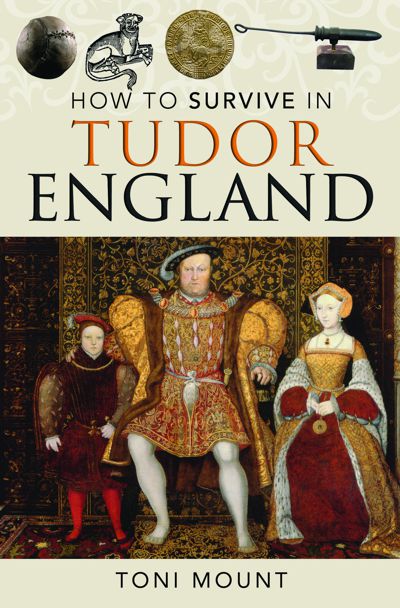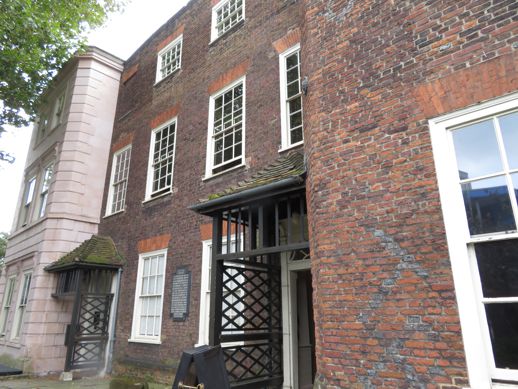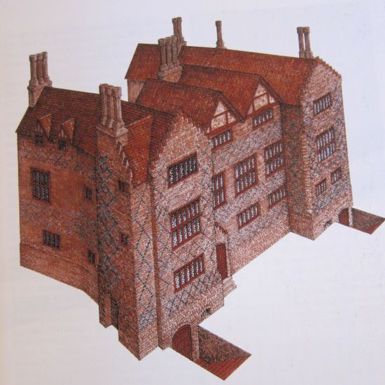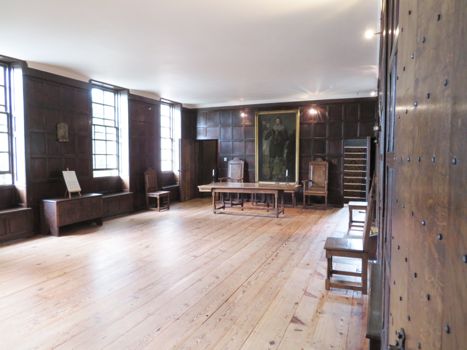
Imagine you were transported back in time to Tudor England and had to start a new life there, without smart phones, internet or social media. When transport means walking or, if you’re lucky, horse-back, how will you know where you are or where to go? Where will you live and where will you work? What will you eat and what shall you wear? And who can you turn to if you fall ill or are mugged in the street, or God-forbid if you upset the king? In a period when execution by be-heading was the fate of thousands how can you keep your head in Tudor England?
All these questions and many more are answered in this new guide book for time-travellers: How to Survive in Tudor England. A handy self-help guide with tips and suggestions to make your visit to the 16th century much more fun, this lively and engaging book will help the reader deal with the new experiences they may encounter and the problems that might occur.
Enjoy interviews with the celebrities of the day, and learn some new words to set the mood for your time-travelling adventure. Have an exciting visit but be sure to keep this book to hand.
Sutton House, Hackney – aka ‘The Brick Place’ and the career of its owner, Ralph Sadleir

When writing my new book How to Survive in Tudor England, I visited many places with a Tudor connection to getfeeling for what it was like to live in that exciting but dangerous era. In Tudor times, the London Borough of Hackney was a village in the countryside, three miles from the filth of the city, renowned for its ‘healthful air’. As an escape from life at the claustrophobic royal court, the stinks and diseases, Hackney was a popular place where the wealthy built their country mansions. Thomas Cromwell had a 1470s mansion in nearby Clapton [Clopton in those days] which he rebuilt as a double-courtyard house in 1535. It was known as ‘the King’s Place’ though my research hasn’t turned up a reason for that name unless it came about because Henry VIII and his estranged daughter, Mary, had a meeting there in 1536. They hadn’t seen each other for five years and the purpose of this family reunion wasn’t to Mary’s advantage because the king bullied her into signing a declaration, admitting her mother, Katherine of Aragon, had never been truly wed to Henry, making Mary illegitimate. This she agreed to do, removing herself from the line of succession to the throne.
While Cromwell was rebuilding the King’s Place, his one-time secretary, Ralph Sadleir, was busy constructing a grand three-story house in Hackney, on Homerton Street. He built in brick which was still a novelty in England and rare enough that calling Ralph’s mansion ‘The Brick Place’ was sufficient as an address – no other brick buildings stood in the area.
The Sadleirs were a Hertfordshire family with Warwickshire ancestry. Ralph’s father, Henry, was involved in the arrangements for Henry VIII’s stupendous Field of the Cloth of Gold meeting with the King of France in 1520, being appointed as ‘purveyor of all the buckram and canvas’ required. Since the entire temporary landscape of palaces, pavilions and banqueting halls was constructed from these textiles, Henry Sadleir must have been working hard and was rewarded, though whether adequately so seems unlikely. Perhaps Henry had an inflated self-image or maybe he just wasn’t very good with finances. Whatever the case, he purchased a country manor in Hackney but had to ask his friend, Thomas Cromwell, to help him raise the £8 2shillings required. This is the manor that would later be rebuilt in brick by his son, Ralph.

Ralph was born either in Hertfordshire, at Standon or possibly in Hackney in 1507. Sources disagree on this. When he was fourteen, just after the Cloth of Gold spectacular had brought his father to notice in high places, he joined Thomas Cromwell’s London household in Fenchurch Street, in the city. He was taught Latin, French, law and courtly skills – all that was needed to do well socially and politically. Cromwell found Ralph to be a great asset and the young man is mentioned as his master’s secretary in 1527 but life was about to change.
In 1533, Ralph married Cromwell’s cousin, Helen or Ellen Barre. She lived in Cromwell’s home in Fenchurch Street where she had been taken in as a destitute woman, abandoned by her husband and left with two small children. It was thought her husband had died in Ireland and Ralph and Helen were married in 1533 and went to live at the newly rebuilt Brick Place in Hackney. Later that year, their son, Thomas, was baptised in St Augustine’s Church in Hackney with Cromwell standing as ‘gossip’ [the medieval/Tudor word for a godparent].
Around this time, Ralph also became employed directly by the king and was involved in the Dissolution of the Monasteries. The king also sent him on diplomatic missions to Scotland and France and he became the king’s principal secretary. However, Cromwell’s fall in 1540 reflected badly on Ralph and he was arrested and sent to the Tower of London, hands tied and guarded by twenty-four men-at-arms. However, unlike Cromwell who was executed, Ralph was soon released and restored to royal favour, receiving a knighthood and serving as a Privy Counsellor to both Henry VIII and Edward VI.
The Brick Place was finished, using the popular ‘H’ plan with two wings and a central range, designed to impress, the bricks being made from clay dug from Hackney Brook which ran just a few yards away from the house. Despite Ralph’s desire for a modern ‘look’, the house was built with some ‘old fashioned’ features that surprised me when we visited. Linen-fold wooden panelling was the latest thing to decorate the walls of the more important rooms, providing insulation as well as looking good. However, to begin with, Ralph went for the cheaper option, having a linen-fold design painted directly onto the plastered walls. Although bright colours were used, this wouldn’t have helped keep the room warm. The real panelling in the Parlour and the Great Chamber upstairs was put over the painted walls at a later date – only Hampton Court and Westminster Abbey have similar panelled rooms, but little cubbyholes in the Parlour open to reveal Ralph’s ‘fake’ design behind.
Another feature that seems quite medieval was Ralph’s staircase to the upper floor. Here is the Great Chamber where important guests would be entertained yet the grand stairway we see today is another later edition. In Ralph’s day, upstairs was accessed by a steep stair not much better than a ladder. I can’t imagine that impressed people of note if they had to climb a ladder like workmen when they came on a visit. However, there were some beautiful modern features that would have created a ‘wow’-factor too. One window, fully glazed, remains from Ralph’s original house, the oak frame dendro-dated to the 1534-35. Many rooms had large ornate fireplaces, bigger than those visible today. This is apparent behind the panelling in the Parlour and the Great Chamber where large brick supporting arches can be seen. Fancy brick chimneys still stand proud above the once-gabled roof but the roof line was altered in the Georgian period when the central range was refaced with new, larger bricks and the sash windows put in. One other vital feature still there today is the garderobe or privy in what was the main bedchamber but is now a Victorian study with the convenience hidden in a cupboard.

Comfortable in their fine new Hackney mansion, the Sadleir family suffered two shocks. The first occurred in 1544 while Ralph was in Edinburgh as ambassador to Scotland. Ralph didn’t like the Scots, describing them as the ‘most beastly and unreasonable people’. And it seems the Scots didn’t like King Henry’s ambassador either because someone shot at him with a musket while he was strolling in the garden. It was a very near miss. Then, in October 1545, Ralph had to rush back to London to deal with a shocking family crisis.
Ralph and Helen had been married for eleven years and had seven children by now. Readers may recall that Helen’s first husband ran off to Ireland where he was believed to have died more than twelve years before. Helen and Matthew Barre had wed in 1526, in Dunmow in Essex and they had two daughters. After her husband disappeared, Helen went to great lengths to find him, visiting his family at Sevenoaks in Kent and making enquiries but he couldn’t be traced.

Now, with Ralph a man of influence and wealth, who should appear, out of the blue, in London but the ‘long-dead’ Matthew Barre!
An enquiry was held and Matthew’s claim to be Helen’s rightful and lawful husband was upheld. This was a terrible blow because, in effect, it made Ralph an adulterer and all their children illegitimate – hardly good for his reputation and standing at court. The only way out of this difficulty was for Ralph to pay for an Act of Parliament, annulling Helen’s marriage to her first husband, as though it had never happened, but this was an expensive business. Fortunately, when Henry VIII drew up his will after Christmas 1546, he left Ralph a bequest of £200 which must have helped and appointed him to the Regency Council to rule England while Edward VI was under age. Ralph continued his diplomatic career under Edward and held numerous offices, including Master of the Great Wardrobe which included responsibility for the Crown Jewels.
In 1550, Ralph sold The Brick Place for £500 to a rich wool merchant and Sheriff of London, John Machell, preferring his new country seat at Standon, near Ware in Hertfordshire but remaining active at court as well. When young Edward wrote his will in 1553, Ralph was a witness and he also signed the documents making Lady Jane Grey queen. Unsurprisingly, when Mary Tudor took the crown, being an active supporter of Protestantism and Queen Jane, Ralph was not in favour. Having been arrested, briefly, and stripped of all his offices, he retired to Standon and lived there quietly for the rest of Mary’s reign.
But Ralph’s career wasn’t finished yet. When Elizabeth became queen in 1558, Ralph resumed his place at court and went on diplomatic missions to Scotland. His knowledge of the Scots and Elizabeth’s trust in him meant he was a likely choice for one of Mary, Queen of Scots’ gaolers during her years of imprisonment in England. From 1584-85, Ralph had charge of Mary, first at Wingfield Manor and then at Tutbury Castle. At Tutbury, Ralph was required to post guards all around the castle and make regular searches of the grounds. However, Francis Walsingham criticised him for taking Mary hawking and giving her too much freedom.
But the Scottish queen’s more pleasant treatment during Ralph’s time as her gaoler couldn’t last. After one plot too many to put her on the English throne, Mary was tried, condemned and executed. Ralph was one of those who sat in judgement at her trial in 1586 but he did not outlive the woman on whom he passed sentence for very long. The following year, aged eighty, Ralph Sadleir died at his manor house at Standon where he has a splendid tomb in the parish church.
There are a few interesting footnotes to Ralph Sadleir’s life and the Brick Place:
- He appears as an important character in Hilary Mantel’s Wolf Hall trilogy of novels.
- There is no certainty as to why the Brick Place became known as Sutton House. In 1605, one Thomas Sutton bought the property next door. It’s thought that with more brick buildings going up in the area, the Sadleir property might have been specified as ‘the one next to Sutton’s house’. The adjoining street is now known as Sutton Place.
- The property is now in the care of the National Trust, unique in that it has never been unoccupied in its long history.
- Regarding Ralph and Helen’s marriage: in 1604, an Act of Parliament was passed – which still applies today – that a spouse absent and presumed dead for seven years becomes officially deceased in the eyes of the law. This would have ensured Ralph’s marriage to Helen was legal from the beginning, had the act existed in 1544.
If you wish to read about many other interesting characters, places, clothing, food and pastimes of the sixteenth century, my new book How to Survive in Tudor England is published on 30th October 2023.
Amazon US: https://www.amazon.com/Survive-Tudor-England-Toni-Mount/dp/1399023284
Amazon UK: https://www.amazon.co.uk/Survive-Tudor-England-Toni-Mount/dp/1399023284
Meet Toni Mount

Toni Mount researches, teaches and writes about history. She is the author of several popular historical non-fiction books and writes regularly for various history magazines. As well as her weekly classes, Toni has created online courses for www.MedievalCourses.com and is the author of the popular Sebastian Foxley series of medieval murder mysteries. She’s a member of the Richard III Society’s Research Committee, a costumed interpreter and speaks often to groups and societies on a range of historical subjects. Toni has a Masters Degree in Medieval Medicine, Diplomas in Literature, Creative Writing, European Humanities and a PGCE. She lives in Kent, England with her husband.
Connect with Toni
Webpage: www.tonimount.com
Facebook: https://www.facebook.com/medievalwriter/
Amazon Author Page: https://www.amazon.co.uk/Toni-Mount/e/B0034P0FF8/
Twitter: https://twitter.com/tonihistorian